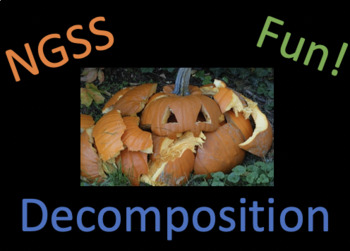NGSS - Decomposition Unit Plan
Teaching Done Right
26 Followers
Grade Levels
6th - 12th, Higher Education, Adult Education, Homeschool, Staff
Resource Type
Standards
NGSSHS-LS2-3
NGSSHS-LS2-7
NGSSMS-LS2-3
NGSSHS-PS3-2
NGSSHS-LS2-4
Formats Included
- Zip
Teaching Done Right
26 Followers
Products in this Bundle (6)
showing 1-5 of 6 products
Description
This NGSS Decomposition Unit Plan is here just in time for Halloween and is complete with
- an anchoring phenomena activity
- a modeling activity
- a lab experiment that students self-design and carry out
- a brief research activity
- two forms of assessments (formal lab report and presentation with rubric).
- detailed lesson plan
At the end of this unit, students will have learned and explored the decomposition process a pumpkin goes through. They will have also researched different methods used to preserve food.
Total Pages
Answer Key
N/A
Teaching Duration
N/A
Report this resource to TPT
Reported resources will be reviewed by our team. Report this resource to let us know if this resource violates TPT’s content guidelines.
Standards
to see state-specific standards (only available in the US).
NGSSHS-LS2-3
Construct and revise an explanation based on evidence for the cycling of matter and flow of energy in aerobic and anaerobic conditions. Emphasis is on conceptual understanding of the role of aerobic and anaerobic respiration in different environments. Assessment does not include the specific chemical processes of either aerobic or anaerobic respiration.
NGSSHS-LS2-7
Design, evaluate, and refine a solution for reducing the impacts of human activities on the environment and biodiversity. Examples of human activities can include urbanization, building dams, and dissemination of invasive species.
NGSSMS-LS2-3
Develop a model to describe the cycling of matter and flow of energy among living and nonliving parts of an ecosystem. Emphasis is on describing the conservation of matter and flow of energy into and out of various ecosystems, and on defining the boundaries of the system. Assessment does not include the use of chemical reactions to describe the processes.
NGSSHS-PS3-2
Develop and use models to illustrate that energy at the macroscopic scale can be accounted for as a combination of energy associated with the motion of particles (objects) and energy associated with the relative position of particles (objects). Examples of phenomena at the macroscopic scale could include the conversion of kinetic energy to thermal energy, the energy stored due to position of an object above the earth, and the energy stored between two electrically-charged plates. Examples of models could include diagrams, drawings, descriptions, and computer simulations.
NGSSHS-LS2-4
Use mathematical representations to support claims for the cycling of matter and flow of energy among organisms in an ecosystem. Emphasis is on using a mathematical model of stored energy in biomass to describe the transfer of energy from one trophic level to another and that matter and energy are conserved as matter cycles and energy flows through ecosystems. Emphasis is on atoms and molecules such as carbon, oxygen, hydrogen and nitrogen being conserved as they move through an ecosystem. Assessment is limited to proportional reasoning to describe the cycling of matter and flow of energy.


